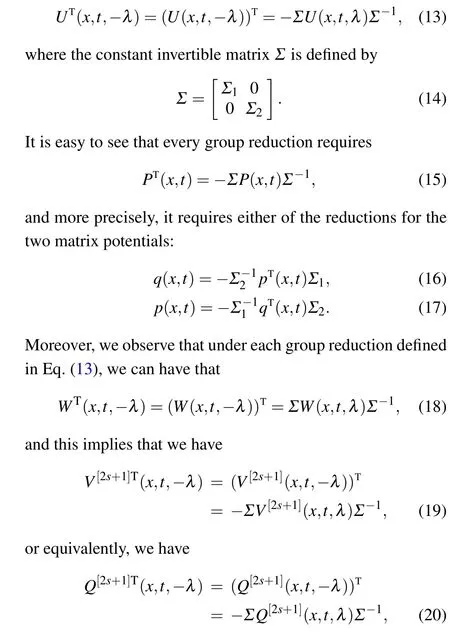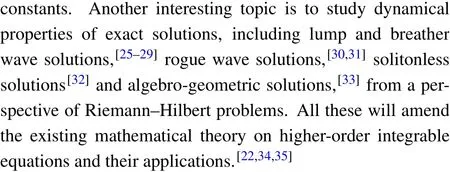Matrix integrable fifth-order mKdV equations and their soliton solutions
2023-03-13WenXiuMa马文秀
Wen-Xiu Ma(马文秀)
1Department of Mathematics,Zhejiang Normal University,Jinhua 321004,China
2Department of Mathematics,King Abdulaziz University,Jeddah 21589,Saudi Arabia
3Department of Mathematics and Statistics,University of South Florida,Tampa,FL 33620-5700,USA
4School of Mathematical and Statistical Sciences,North-West University,Mafikeng Campus,Private Bag X2046,Mmabatho 2735,South Africa
Keywords: matrix integrable equation,Riemann-Hilbert problem,soliton
1.Introduction
Integrable equations describe diverse nonlinear phenomena in applied and engineering sciences.[1]Two paradigmatic examples are the nonlinear Schr¨odinger (NLS) equation and the modified Korteweg-de Vries(mKdV)equation,both local and nonlocal(see,e.g.,Refs.[2,3]).Lax pairs of matrix spectral problems play a fundamental role in solving their Cauchy problems by the inverse scattering transform.
Group reductions of matrix spectral problems can produce reduced integrable equations and keep the integrable structures that the original integrable equations exhibit (see,e.g., Refs.[4-6] for nonlocal reduced integrable equations).When one group reduction is taken, we obtain a kind of local matrix integrable NLS equations and two kinds of local matrix integrable mKdV equations,[2,7]based on two classes of local group reductions; and three kinds of nonlocal matrix integrable NLS equations and two kinds of nonlocal matrix integrable mKdV equations,based on nine classes of nonlocal group reductions.[3,4]
The Riemann-Hilbert technique has been shown to be one of powerful methods to solve integrable equations, and particularly to construct soliton solutions.[8,9]Various kinds of integrable equations have been studied by the associated Riemann-Hilbert problems (see, e.g., Refs.[10-12] and Refs.[6,13-15]for details in the local and nonlocal cases,respectively).On the other hand, higher-order integrable equations are introduced to describe nonlinear dispersive waves in optical fibers and water waves (see, e.g., Refs.[16,17]).In this paper,we would like to construct a kind of reduced matrix mKdV hierarchies, including reduced matrix integrable fifthorder mKdV equations.Riemann-Hilbert problems will be used to present soliton solutions to the resulting reduced matrix integrable mKdV equations of odd order.
The rest of this paper is organized as follows.In Section 2, we make a kind of group reductions of the Ablowitz-Kaup-Newell-Segur (AKNS) matrix spectral problems to generate reduced matrix integrable mKdV hierarchies.In Section 3, based on properties of eigenvalue and adjoint eigenvalue problems, we solve the corresponding reflectionless Riemann-Hilbert problems, where eigenvalues could equal adjoint eigenvalues, and compute soliton solutions to the resulting reduced matrix integrable odd-order mKdV equations,particularly to the scalar integrable fifth-order mKdV equation and a two-component system of integrable fifth-order mKdV equations.The final section gives a conclusion and a few concluding remarks.
2.Reduced matrix integrable mKdV hierarchies
2.1.The matrix AKNS integrable hierarchies revisited
Let us first recall the AKNS hierarchies of matrix integrable equations,which will be used in the subsequent analysis.As normal,we assume thatpandqare two matrix potentials:
wherem,n ≥1 are two given integers.We take the matrix AKNS spectral problems as follows:
whereλis the spectral parameter.Moreover, the constant square matricesΛandΩare defined by

whereα=α1-α2andβ=β1-β2are arbitrary nonzero constants, and the two matrix potentialspandqare defined in Eq.(1).
2.2.Reduced matrix integrable mKdV hierarchies
We would like to construct a kind of novel reduced matrix integrable mKdV equations of odd order by taking one kind of group reductions for the matrix AKNS spectral problems in Eq.(2),which is different from the one in Refs.[2,19].
Assume thatΣ1andΣ2are a pair of constant invertible symmetric matrices of sizesmandn,respectively.Let us consider a kind of group reductions for the spectral matrixU:

wheres ≥0.
Consequently, it is direct to see that under one potential reduction defined by Eq.(16) or Eq.(17), the integrable matrix AKNS equations in(10)withr=2s+1, s ≥0,reduce to one hierarchy of reduced matrix integrable mKdV equations of odd order
wherepis anm×nmatrix potential,or

withqbeing ann×mmatrix potential.In the above reduced matrix integrable equations,Σ1andΣ2are a pair of arbitrary invertible symmetric matrices of sizesmandn, respectively.Each reduced equation in the hierarchy (21) or (22) with a fixed integers ≥0 possesses a Lax pair of the reduced spatial and temporal matrix spectral problems in Eq.(2) withr=2s+1,and infinitely many symmetries and conserved densities from those for the integrable matrix AKNS equations in Eq.(10)withr=2s+1.
If we takes=2, namely,r=5, then the reduced matrix integrable mKdV type equations (21) give a kind of reduced matrix integrable fifth-order mKdV equations
wherepis anm×nmatrix potential, andΣ1andΣ2are two arbitrary constant invertible symmetric matrices of sizesmandn,respectively.
In what follows,we are going to compute two illustrative examples of these novel reduced matrix integrable fifth-order mKdV equations,by selecting different values form,nand appropriate choices forΣ.
Let us first considerm=n=1.When we set
we obtain the scalar integrable fifth-order mKdV equation
wherep=(p1),andσ/=0 is an arbitrary complex constant.
Let us secondly considerm=1 andn=2.When we set
we obtain a two-component system of integrable fifth-order mKdV equations
wherep=(p1,p2), andσ1andσ2are two arbitrary nonzero complex constants.
3.Soliton solutions via Riemann-Hilbert problems
3.1.Properties of eigenvalue and adjoint eigenvalue problems
Under the group reductions in Eq.(13),we can see thatλis an eigenvalue of the matrix spectral problems in Eq.(2) if and only if ˆλ=-λis an adjoint eigenvalue, i.e., the adjoint matrix spectral problems hold:
wherer=2s+1, s ≥0.
On the other hand, under each group reduction in Eq.(13), ifφ(λ) is an eigenfunction of the matrix spectral problems in Eq.(2)associated with an eigenvalueλ,then we can see thatφT(-λ)Σgives an adjoint eigenfunction associated with the same eigenvalueλ.
3.2.Solutions to reflectionless Riemnn-Hilbert problems
We would like to establish a formulation of solutions to the corresponding reflectionless Riemann-Hilbert problems.
LetN ≥0 be an arbitrary integer.First, let us takeNeigenvaluesλkandNadjoint eigenvalues ˆλkas follows:
whereµk ∈C,1≤k ≤N,and assume that their corresponding eigenfunctions and adjoint eigenfunctions are denoted by
respectively.If we do not have the property
we need to define the following generalized solutions to reflectionless Riemann-Hilbert problems:
whereMis a square matrix of sizeN, with its entries being defined by
As shown in Ref.[14],these two matricesG+(λ)andG-(λ)solve the reflectionless Riemann-Hilbert problem
when we have the orthogonal condition
where 1≤k,l ≤N.
3.3.Soliton solutions
When we take zero potentials in the matrix spectral problems in Eq.(2),we can obtain
and following the preceding analysis,we can take
wherewk, 1≤k ≤N, are arbitrary constant column vectors.In this way,the orthogonal condition(35)becomes
where 1≤k,l ≤N.
Now,as normal,making an asymptotic expansion
asλ →∞,we arrive at
and further, substituting this into the matrix spatial spectral problems,we get the potential matrix
This gives rise to theN-soliton solutions to the matrix integrable AKNS equations(10)
This means that the resulting potential matrixPdefined by Eq.(41) will satisfy the group reduction condition (15).As a consequence, the aboveN-soliton solutions to the matrix AKNS integrable equations(10)reduce to the following class ofN-soliton solutions:
to the reduced matrix integrable mKdV equations of odd order in Eq.(21).To summarize,when the orthogonal condition forwk, 1≤k ≤N, in Eq.(38) and the involution property in Eq.(43)are satisfied,the formula(44),together with Eqs.(32),(33),(36)and(37),presentsN-soliton solutions to the reduced matrix integrable mKdV equations of odd order in Eq.(21).
Finally, let us compute two examples of one-soliton solutions in the cases ofm=n=1 andm=n/2=1.We takeλ1=µ1,ˆλ1=-µ1,whereµ1∈C,µ1/=0,and choose
wherew1,1,w1,2,w1,3∈C are arbitrary constants.The first situation yields a class of one-soliton solutions to the integrable fifth-order mKdV equation(25):
whereµ1,w1,1,w1,2∈C are arbitrary nonzero constants.The second situation generates the following choice for one-soliton solutions to the integrable fifth-order mKdV equations(27):
They solve the integrable fifth-order mKdV equations (27) if and only if the condition
is satisfied,which is a consequence of the involution property in Eq.(43).Therefore, the one-soliton solutions of Eq.(27)formulated above read
whereµ1,w1,1,w1,2,w1,3∈C are arbitrary nonzero constants,butw1,2andw1,3need to satisfy Eq.(48).
4.Concluding remarks
A kind of reduced matrix local integrable mKdV equations of odd order and their soliton solutions have been constructed.The construction is based on a new kind of group reductions for the AKNS matrix spectral problems.Two illustrative examples of the resulting matrix integrable fifth-order mKdV equations have been presented.
We remark that it would be interesting to look for other kinds of reduced local integrable equations from different kinds of Lax pairs,[20,21]variable-coefficient integrable equations[22]and integrable couplings.[23]In the presented group reductions,we can also take


Acknowledgements
The work was supported in part by the National Natural Science Foundation of China (Grant Nos.11975145,11972291,and 51771083),the Ministry of Science and Technology of China(Grant No.G2021016032L),and the Natural Science Foundation for Colleges and Universities in Jiangsu Province,China(Grant No.17 KJB 110020).
杂志排行
Chinese Physics B的其它文章
- Comparison of differential evolution,particle swarm optimization,quantum-behaved particle swarm optimization,and quantum evolutionary algorithm for preparation of quantum states
- Explicit K-symplectic methods for nonseparable non-canonical Hamiltonian systems
- Molecular dynamics study of interactions between edge dislocation and irradiation-induced defects in Fe-10Ni-20Cr alloy
- Engineering topological state transfer in four-period Su-Schrieffer-Heeger chain
- Spontaneous emission of a moving atom in a waveguide of rectangular cross section
- Novel traveling quantum anonymous voting scheme via GHZ states
